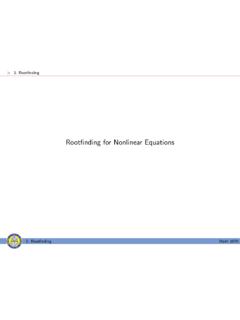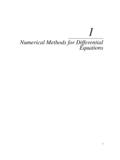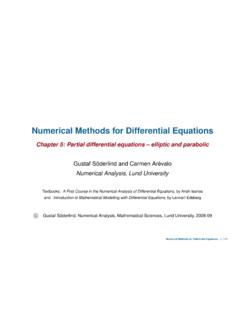Transcription of Introduction to Numerical Methods and Matlab …
1 Introduction to Numerical Methods and Matlab programming for Engineers Todd Young and Martin J. Mohlenkamp Department of Mathematics Ohio University Athens, OH 45701. May 4, 2017. ii Copyright c 2008, 2009, 2011, 2014, 2016, 2017 Todd R. Young and Martin J. Mohlenkamp. Original edition 2004, by Todd R. Young. This work is licensed under the Creative Commons Attribution-NonCommercial-ShareAlike International License. To view a copy of this license, visit Preface These notes were developed by the first author in the process of teaching a course on applied Numerical Methods for Civil Engineering majors during 2002-2004 and was modified to include Mechanical Engineering in 2005. The materials have been periodically updated since then and underwent a major revision by the second author in 2006-2007. The main goals of these lectures are to introduce concepts of Numerical Methods and introduce Matlab in an Engineering framework. By this we do not mean that every problem is a real life.
2 Engineering application, but more that the engineering way of thinking is emphasized throughout the discussion. The philosophy of this book was formed over the course of many years. My father was a Civil Engineer and surveyor, and he introduced me to engineering ideas from an early age. At the University of Kentucky I took most of the basic Engineering courses while getting a Bachelor's degree in Mathematics. Immediately afterward I completed a degree in Engineering Mechanics at Kentucky. While working on my in Mathematics at Georgia Tech I taught all of the introductory math courses for engineers. During my education, I observed that incorporation of computation in coursework had been extremely unfocused and poor. For instance during my college career I had to learn 8 different programming and markup languages on 4 different platforms plus numerous other software applications. There was almost no technical help provided in the courses and I wasted innumerable hours figuring out software on my own.
3 A typical, but useless, inclusion of software has been (and still is in most calculus books) to set up a difficult applied' problem and then add the line write a program to solve or use a computer algebra system to solve . At Ohio University we have tried to take a much more disciplined and focused approach. The Russ College of Engineering and Technology decided that Matlab should be the primary computational software for undergraduates. At about the same time members of the Department of Mathematics proposed an 1804 project to bring Matlab into the calculus sequence and provide access to the program at nearly all computers on campus, including in the dorm rooms. The stated goal of this project was to make Matlab the universal language for computation on campus. That project was approved and implemented in the 2001-2002 academic year. In these lecture notes, instruction on using Matlab is dispersed through the material on Numerical Methods . In these lectures details about how to use Matlab are detailed (but not verbose) and explicit.
4 To teach programming , students are usually given examples of working programs and are asked to make modifications. The lectures are designed to be used in a computer classroom, but could be used in a lecture format iii iv PREFACE. with students doing computer exercises afterward. The lectures are divided into four Parts with a summary provided at the end of each Part. Todd Young Dependencies Below we give the dependencies between Lectures. Almost everything depends on Lectures 1 4, so those links are omitted to reduce clutter. Some lectures, marked with * in the table of contents, have not yet been developed. Part II. 13 18. 16-17. 8 9 12 14. 15. 10 11. Part III. 19-20 24. 22 25. 21 23. 28. Part I 27 26. 7 Part IV. 35 36-37. 1-4 5-6. 41-42 38-39. Everything in Parts II,III,IV. 33 34. 29-32. Contents Preface iii I Matlab and Solving Equations 1. Lecture 1. Vectors, Functions, and Plots in Matlab 2. Lecture 2. Matlab Programs 6. Lecture 3. Newton's Method and Loops 10. Lecture 4.
5 Controlling Error and Conditional Statements 14. Lecture 5. The Bisection Method and Locating Roots 18. Lecture 6. Secant Methods 22. Lecture 7. Symbolic Computations 25. Review of Part I 29. II Linear Algebra 33. Lecture 8. Matrices and Matrix Operations in Matlab 34. Lecture 9. Introduction to Linear Systems 39. Lecture 10. Some Facts About Linear Systems 43. Lecture 11. Accuracy, Condition Numbers and Pivoting 46. Lecture 12. LU Decomposition 50. Lecture 13. Nonlinear Systems - Newton's Method 53. Lecture 14. Eigenvalues and Eigenvectors 57. Lecture 15. Vibrational Modes and Frequencies 60. Lecture 16. Numerical Methods for Eigenvalues 63. v vi CONTENTS. Lecture 17. The QR Method* 67. Lecture 18. Iterative solution of linear systems* 69. Review of Part II 70. III Functions and Data 73. Lecture 19. Polynomial and Spline Interpolation 74. Lecture 20. Least Squares Fitting: Noisy Data 78. Lecture 21. Integration: Left, Right and Trapezoid Rules 81. Lecture 22. Integration: Midpoint and Simpson's Rules 86.
6 Lecture 23. Plotting Functions of Two Variables 90. Lecture 24. Double Integrals for Rectangles 93. Lecture 25. Double Integrals for Non-rectangles 97. Lecture 26. Gaussian Quadrature* 100. Lecture 27. Numerical Differentiation 101. Lecture 28. The Main Sources of Error 105. Review of Part III 108. IV Differential Equations 115. Lecture 29. Reduction of Higher Order Equations to Systems 116. Lecture 30. Euler Methods 120. Lecture 31. Higher Order Methods 124. Lecture 32. Multi-step Methods * 127. Lecture 33. ODE Boundary Value Problems and Finite Differences 128. Lecture 34. Finite Difference Method Nonlinear ODE 132. Lecture 35. Parabolic PDEs - Explicit Method 135. Lecture 36. Solution Instability for the Explicit Method 140. CONTENTS vii Lecture 37. Implicit Methods 143. Lecture 38. Insulated Boundary Conditions 147. Lecture 39. Finite Difference Method for Elliptic PDEs 152. Lecture 40. Convection-Diffusion Equations* 155. Lecture 41. Finite Elements 156. Lecture 42.
7 Determining Internal Node Values 160. Review of Part IV 164. V Appendices 167. Lecture A. Glossary of Matlab Commands 168. viii CONTENTS. Part I. Matlab and Solving Equations Copyright, c Todd Young and Martin Mohlenkamp, Department of Mathematics, Ohio University, 2017. Lecture 1. Vectors, Functions, and Plots in Matlab In these notes will indicate commands to be entered at the Matlab prompt >> in the command window. You do not type the symbol |. Entering vectors In Matlab , the basic objects are matrices, arrays of numbers. Vectors can be thought of as special matrices. A row vector is recorded as a 1 n matrix and a column vector is recorded as a m 1 matrix. To enter a row vector in Matlab , type the following in the command window: v = [0 1 2 3]. and press enter. Matlab will print out the row vector. To enter a column vector type u = [9; 10; 11; 12; 13]. You can access an entry in a vector with u (2). and change the value of that entry with u (2)=47. You can extract a slice out of a vector with u (2:4).
8 You can change a row vector into a column vector, and vice versa easily in Matlab using w = v'. (This is called transposing the vector and we call ' the transpose operator.) There are also useful shortcuts to make vectors such as 2. 3. x = -1:.1:1. y = linspace (0 ,1 ,11). Basic Formatting To make Matlab put fewer blank lines in its output, enter format compact To make Matlab display more digits, enter format long Note that this does not change the number of digits Matlab is using in its calculations; it only changes what is diplayed. Plotting Data Consider the data in Table We can enter this data into Matlab with the following commands entered T (C ) 5 20 30 50 55. Table : Viscosity of a liquid as a function of temperature. in the command window: x = [ 5 20 30 50 55 ]. y = [ ]. Entering the name of the variable retrieves its current values. For instance x y We can plot data in the form of vectors using the plot command: plot (x , y ). This will produce a graph with the data points connected by lines.
9 If you would prefer that the data points be represented by symbols you can do so. For instance plot (x ,y , '* '). plot (x ,y , 'o '). plot (x ,y , '. '). 1. Adapted from Ayyup &McCuen 1996, 4 LECTURE 1. VECTORS, FUNCTIONS, AND PLOTS IN Matlab . Data as a Representation of a Function A major theme in this course is that often we are interested in a certain function y = f (x), but the only information we have about this function is a discrete set of data {(xi , yi )}. Plotting the data, as we did above, can be thought of envisioning the function using just the data. We will find later that we can also do other things with the function, like differentiating and integrating, just using the available data. Numerical Methods , the topic of this course, means doing mathematics by computer. Since a computer can only store a finite amount of information, we will almost always be working with a finite, discrete set of values of the function (data), rather than a formula for the function.
10 Built-in Functions If we wish to deal with formulas for functions, Matlab contains a number of built-in functions, including all the usual functions, such as sin( ), exp( ), The meaning of most of these is clear. The dependent variable (input) always goes in parentheses in Matlab . For instance sin ( pi ). should return the value of sin , which is of course 0 and exp (0). will return e0 which is 1. More importantly, the built-in functions can operate not only on single numbers but on vectors. For example x = linspace (0 ,2* pi ,40). y = sin ( x ). plot (x , y ). will return a plot of sin x on the interval [0, 2 ]. Some of the built-in functions in Matlab include: cos( ), tan( ), sinh( ), cosh( ), log( ) (natural logarithm), log10( ) (log base 10), asin( ) (inverse sine), acos( ), atan( ). To find out more about a function, use the help command; try help plot User-Defined Anonymous Functions If we wish to deal with a function that is a combination of the built-in functions, Matlab has a couple of ways for the user to define functions.







